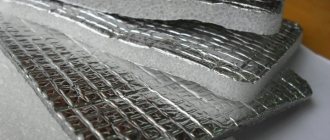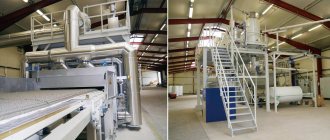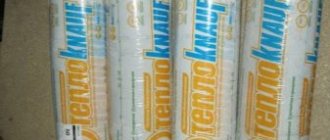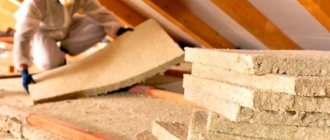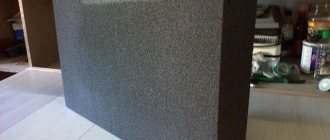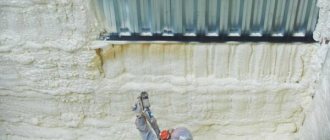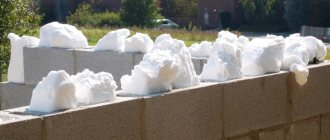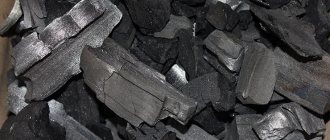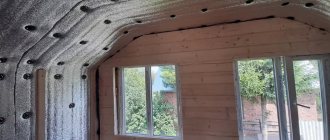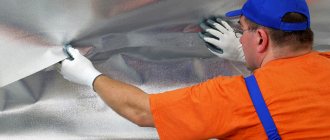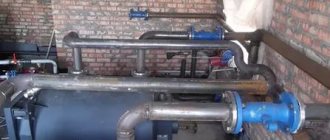Today, to carry out thermal insulation measures inside/outside a building and utilities, manufacturers offer a variety of different solutions to choose from. Let's consider a roll material such as foil penofol: technical characteristics, use as main or additional insulation and variety of types. Let's get acquainted with the features of installation work.
Penofol with one-sided foil coating Source kmkomplekt.ru
Technical characteristics of Penofol
The material has waterproofing properties and low thermal conductivity.
Some types of Penofol, for example, products of type “A” are highly specialized and are suitable for rooms with average room temperature. Main technical characteristics of Penofol insulation:
- Thickness. The thickness of the material is directly proportional to the level of thermal conductivity. Penofol is available in the following thicknesses: 3, 4, 5, 8 and 10 mm. The most commonly used insulation is 1 cm thick. This material retains heat in the room for a long time and has increased sound insulation.
- Thermal conductivity. An important indicator for each insulation. The basis of the material is 2 characteristics: absorption and reflection of heat flow. The aluminum surface reflects back more than 90% of the heat. Insulation with a thickness of 0.5 cm in thermal conductivity corresponds to a mineral wool slab, the thickness of which must be at least 1 cm.
- Resistance to prolonged exposure to moisture. Penofol does not absorb liquid, regardless of external or internal installation. Resistance to moisture is not affected in any way by temperature, change of day or season.
- Vapor permeability class. It is 0.001 mg/(m·h·Pa), which is a fairly low figure. Therefore, for this insulation it is not necessary to use an additional layer of vapor barrier. The material perfectly retains any level of evaporation.
- Sound permeability. Penofol has a high level of sound permeability, even class “A” with one layer of aluminum has a sound permeability of 32 dB. Installing insulation on top of the material used (for example, lining) will only improve the sound insulation in the room.
- Flammability. An important safety criterion for any category of insulation. When exposed to fire, Penofol melts rather than burns, releasing carbon dioxide. If the fire lasts for a long time, carbon monoxide of a weak consistency may appear.
High-quality and flexible material
Penofol insulation meets all established operating criteria. It can be laid both under the main building material and on top of it. Used in wooden, brick, concrete and clay buildings.
Installation rules
Depending on the scope of penofol application, the methods of its installation differ. To carry out installation work on laying material on the balcony, you should be guided by the following technology:
- To begin with, you should remember that there should be a distance of 1-2 cm between the structural elements and the penofol. Such a margin is required in order to eliminate the possibility of moisture and ventilation;
- Penofol should be laid with the foil side directly to the heat source;
- The material must be connected using special foil tape;
- Penofol sheets should be connected to each other end-to-end, which allows you to achieve maximum thermal reflection.
Unique characteristics of Penofol
Penofol is an insulation material defined as a heat-noise-moisture-insulating material. It is made from environmentally friendly substances, and is thin and light in weight. In industrial and civil construction it is used for:
- basement insulation;
- wall insulation;
- attic insulation;
- ceiling insulation;
- roof insulation;
- floor insulation;
- hydrothermal insulation of pipes;
- thermal insulation of air conditioner;
- hydrothermal insulation of external walls;
- strengthening waterproofing and massive insulation;
- dust protection;
- repair of ceiling covering;
- strengthening walls;
- door insulation;
- insulation of water heating elements.
In the automotive industry, Penofol is used as a material for sound insulation and insulation of vehicle interiors.
Soundproofing
A unique property of Penofol is its ability to provide good sound insulation with a small insulation thickness. This property is actively used in the automotive industry and, if desired, can reduce noise from extraneous factors at home.
Considering that this material can be used both indoors and outdoors, and with a thickness of only 4-5 mm it can significantly reduce the noise of the apartment, this is undoubtedly a useful quality of insulation.
Penofol has sound absorption above 32 dB.
How to install reflective insulation on a concrete wall
How or with what can you glue or attach reflective insulation to a concrete wall? Thank you.
Reflective insulation is a lightweight, flexible material with a thickness of 4 mm or more, consisting of a layer of foamed polyethylene or other polymer, onto which aluminum foil or metallized film is glued on one or both sides. Foil thermal insulation materials are environmentally friendly, easy to install and significantly reduce heat loss.
Manufacturers of reflective thermal insulation materials do not exclude the use of glue during installation, but draw the attention of consumers that they are most effective if an air gap of 2 to 10 mm is created between the wall and the thermal insulation. After all, air is also an additional thermal insulation layer
The method of attaching reflective thermal insulation to a concrete wall is chosen depending on the type of material, capabilities, location and purpose of the room. In any case, the concrete wall must first be cleaned of dust and treated with an antiseptic, and if necessary, dried.
When insulating balconies or cold external walls with a heat insulator with a double-sided foil coating, it is necessary to fill the concrete with a lathing of slats 5-7 mm thick and attach the material to it with a construction stapler or glue. A second sheathing is mounted on top of the heat-insulating material for laying the finishing coating with an air gap.
When installing on reflective materials with a one-sided metallized coating, it is allowed to use rubber or acrylic-based adhesives such as 88-NP, Akrol Contact, Neoprene 2136 spray, etc. You can also use polyurethane foam, sealing sealant and double-sided reinforced construction tape . The adhesive composition is applied to the back side of the material pointwise in a checkerboard pattern or randomly, so that after gluing to the concrete the required air gap of about 2 mm remains.
Reflective insulation sheets are glued end to end and the seams must be taped with aluminum tape. As a result, an airtight coating is created on the wall, reminiscent of a thermos, onto which a lath of slats can be mounted to secure the finishing material.
Finally, if increasing the thickness of the walls is undesirable or impossible, self-adhesive foil thermal insulation material can be used for insulation. To install it, you only need to prepare the concrete surface and remove the protective film from the underside of the canvas, and after gluing, seal the joints with foil tape. But when fastened to the sheathing, the efficiency of self-adhesive metallized insulation is higher.
How to install reflective insulation on a concrete wall?
Tips on the method of fastening reflective thermal insulation to a concrete wall, depending on the type of material, purpose and capabilities of the room
What to glue it with?
A correctly selected adhesive solution for foil material does not yet guarantee a successful installation. For a quality connection of materials, it is necessary that the surface to be glued be carefully prepared. All defects, irregularities, and various debris must be eliminated.
To improve adhesion, materials made of metal, concrete and wood can be treated with a special primer solution.
Concrete floors and walls are leveled, cracks are sealed, and metal products are treated with an anti-corrosion agent.
Adhesive for foil insulation can be either specialized or universal. You can also use liquid nails, double-sided tape, or a thin layer of foam. The choice of glue depends entirely on the purpose of the surface and its further use.
The adhesive composition must correspond to the performance indicators of the insulating material:
- permission for indoor use;
- the toxicity of the solution should be 0;
- high resistance to adhesion;
- the glue must withstand temperatures in the range of -60 to +100 degrees.
If insulation is carried out externally, then the adhesive solution must be resistant to water vapor and liquid.
In order for penofol to be reliably glued to the surface, the glue must be applied to the side that does not have a foil layer. The adhesive solution is applied evenly, without gaps. The edges of the panel are carefully coated with glue so that the foil material does not come off during operation.
Before you start fixing the penofol, you need to wait 5-60 seconds for the glue to dry slightly. This ensures better adhesion to the products. Penofol is pressed to the surface, holding it, and smoothed out with special care.
If the insulation is glued in pieces, then the joints are additionally glued.
What is penofol
Self-adhesive penofol is a new insulating coating that has not only good thermal and waterproofing, but also protection functions against various types of radiation. The material has received a wide vocation in the construction industry thanks to the latest manufacturing technology with a one-sided self-adhesive side, which significantly increases the speed of installation of such insulation
It can be installed on the roof and retains more than 80% of the internal heat of the building, protects the walls, prevents the obvious consequences of heat stroke in the summer and sudden frost in the winter. Penofol has a thickness from 3 mm to 10 mm, the roll width ranges from 20 mm to 120 mm. Common sizes of self-adhesive polyethylene are: width 58 cm, thickness 3-5 mm.
Shielding properties, protection from moisture, retain heat and provide overall energy savings - all this is affected by the thickness of the penofol
. Penofol has characteristics similar to foam boards, but its dimensions are much smaller and the coating is very thin. Let's take a look at the basic properties of penofol:
- No odor or toxicity.
- Lightweight, soft, dust-free.
- Easy to install.
- Heat reflection, thermal insulation, sound insulation, anti-radiation, anti-vibration and shielding.
- Sunscreen barrier, waterproof, energy saving.
- Retains heat in winter and coolness in summer.
- Saves thermal and electrical energy.
Penofol technical characteristics:
- resistance to extreme temperatures from + 0 °C to 150 °C;
- due to the “mirror” reflection of the surface, thermal air currents arise, providing convection in the room;
- uniform heat distribution throughout the heated space;
- thermal reflection coefficient up to 95%;
- waterproof material that expands the range of use of insulating foil (walls, ceilings, floors);
- ease of installation allows you to do the installation work yourself;
- The thermal conductivity of penofol is 0.037-0.051 (for different types).
Penofol insulation has technical characteristics ideal for thermal, hydraulic and vapor insulation. Penofol is good for use both for insulating apartments, private houses, and for warehouses, hangars, and workshops.
The properties of self-adhesive polyethylene foam can be used for shielding rooms with high humidity: baths, showers, changing rooms in swimming pools, saunas. Those. this material is in great demand during construction work on insulation of various objects where constant humidity or steam will be present.
In addition, foamed polyethylene perfectly absorbs sound waves and mechanical vibration. These properties are used in the construction of operator cabins (for example, boiler rooms or steelmaking). The advantage of using penofol in this case is simply ideal: it eliminates sound, absorbs vibration, and creates a heat shield.
Foil self-adhesive penofol is often used for insulating boiler equipment, shielding various cables, and insulating pipes. Such insulation will be useful when laying networks below ground level, where there is high humidity and the insulating material does not absorb moisture.
Advantages and disadvantages
The use of penofol has its advantages:
- The small thickness of the material allows you to create reliable thermal insulation of the room.
- Installation of building materials does not require special skills or special tools. Working with this material is much easier than with other types of insulation.
- The material is environmentally friendly, which makes it possible to use it for storing food.
- Fire safety. This building material belongs to the class of fire-resistant materials.
- Ease of transportation. The thickness of the product allows the insulation to be rolled up, which allows it to be transported in the luggage compartment of a car.
- Excellent sound insulation. Mounting penofol on top of the frame of building structures provides good insulation of extraneous sounds.
Penofol has not only positive qualities. There are also disadvantages to using this building material:
- The insulation is soft. Because of this, this product is not used for finishing plastered walls. When lightly pressed, the material bends.
- To fix the insulation you will need special adhesives. It is not recommended to nail it to the surface, because in this way penofol loses its thermal insulation qualities.
Foil insulation for walls and floors
Foil insulation has relatively recently appeared on the construction market, but is rapidly gaining popularity for various reasons. Next, we will consider the types of this material, the advantages in comparison with traditional insulation and how to use it correctly.
What is rolled foil insulation
This is a combined material for insulating walls, floors and ceilings, consisting of several layers:
- Insulation made from familiar materials.
- A layer of foil.
The material is rolled, therefore it has a relatively small sheet thickness. How does heat retention occur?
- A thin working layer delays the penetration of cold air from outside,
- The foil reflects heated air into the room.
Varieties
Roll insulation materials are classified according to the main material:
- Foamed polyethylene with foil that can be attached on one or both sides.
- Folgoizol is created on the basis of bitumen/rubber, mineral fillers and antiseptic.
- Mineral wool rolls with one-sided foil surface.
- Basalt lamella insulation,
- Expanded polystyrene boards with one aluminum surface.
Each of the presented materials is intended for use in certain conditions.
Application
Penefol (closed cell polyethylene foam) is versatile in use. They insulate walls and floors in residential premises.
Foil insulation for pipes and roofing - foil insulation. It is also used in the construction of industrial facilities.
Rolls of mineral wool with an aluminum layer are used in the same way as conventional insulating mats: for insulating walls, floors and other structures. The difference between foil-coated mineral wool and regular wool is the built-in waterproofing; aluminum does not allow moisture to pass into the fibers, preventing the material from getting wet.
The ideal insulation foil for a bathhouse is based on basalt: it has a low heat transfer coefficient, is not afraid of humidity and large temperature changes. As you know, stone wool is a hard material. To roll it into a roll, the basalt is sawed into lamellas, which are laid on an aluminum base. This insulation is used to insulate various social and industrial facilities.
Foiled polystyrene foam is used for floor insulation.
All materials with a layer of aluminum foil have higher technical performance than their traditional form. The cost of foil insulation is an order of magnitude higher than the cost of conventional material; this is the main disadvantage of the “advanced” sample.
The first and most important question is which side to put the foil insulation on?
The first rule of installation: the reflective side should be directed towards the room. This will ensure natural heat reflection.
The structure of insulation and finishing must be thought out: in the case of walls, there must be an air gap between the insulation and subsequent finishing. When using a mineral wool base, it is necessary to insulate the material from the penetration of water; for this, a membrane is attached to the base, allowing steam to pass out.
How to attach foil insulation to a wall: roll out the insulator over the fixed membrane and fix it with guide rails, the thickness of which should exceed the thickness of the main insulation. The layers are connected with staples along the edges of the slats. Subsequent finishing of panels or lining is carried out along guides, which provide an air gap with their thickness.
Some craftsmen recommend protecting the foil with vapor-proof films to prevent moisture from entering the body of the mineral wool layer through possible holes in the metal.
For wooden and concrete floors, the algorithm of actions remains identical:
- The base is cleaned of old coatings, and debris is carefully swept away.
- Prime the subfloor with a concrete or wood primer.
- After the primer has dried, measure out the required amount of roll insulation and roll it out. It is optimal to use adhesive-based material. The strips are laid with an overlap of 10 cm, the joints are taped with aluminum tape.
- The finishing coating is laid on top.
If the room has an electric or water “warm” floor, the rolls are rolled out with the reflective side up, a reinforcing mesh is laid on top, then heating elements and a cement screed is produced followed by cladding.
Foil insulation for walls and floors
Let's look at the types of foil insulation, its advantages over traditional insulation, and how to use it correctly.
Features of foil insulation, some disadvantages and scope of application. How to properly install penofol with glue. The choice between penofol and basalt wool.
Application
As a heat insulator:
- for houses;
- saunas and baths;
- hangars;
- warehouses;
- refrigeration chambers;
- shops and pavilions;
- air conditioning systems.
As an additional element of the structure:
- for internal and external walls;
- floors and ceilings;
- steam, hydro and heat insulators for roofs and attic floors;
- as a shielding heat reflector for heating radiators;
- insulator for doors and windows.
Where is Penofol used?
Based on the above, it can be understood that Penofol insulation has simply universal technical characteristics. And therefore it can be used both for thermal insulation of light summer houses in holiday villages, and for insulation of high-rise buildings. Offices, industrial premises, kindergartens, hospitals, saunas and baths can be insulated with this material. They also insulate warehouses with hangars, both heated and unheated. Stalls and modules for trade, temporary huts and refrigeration rooms can also be insulated with Penofol. They also wrap pipes (plumbing, ventilation and heating), insulate carriages, vans and cars, and shield heating radiators.
Penofol, which has a foil coating on both sides, will not only help keep you warm on frosty days. Placed under the roof, it will not allow the scorching summer heat to enter the house. So, for example, laying Penofol with double-sided foil, having type “B” and a thickness of 5 millimeters, leaving two layers of air of 2 centimeters each. The result will not be long in coming: the thermal resistance of the structure will increase by 1.2 square meters-degrees Celsius per watt.
Reviews
There are many reviews from owners about penofol insulation in their homes. Olga said that they live in a multi-storey building and with the onset of cold weather, the need for insulation arose. Friends recommended foil insulation. He says that its cost is very affordable when compared with other materials. They laid it under linoleum and trimmed all the cracks in the windows with it. They were pleased with the result - their apartment became much warmer and more comfortable.
Then Igor told me that he had purchased a small summer cottage. He began to build a wooden house, a cottage and a garage on it. I wanted to insulate all these buildings at once. To insulate the bathhouse, he took foil-lined penofol.
I asked the sellers for a quality certificate to avoid fakes. Using this material, he insulated the roof, walls, and floor of the bathhouse. He shares that after one fire, the high temperature lasts for about two days. He is pleased and recommends this material to everyone.
Getting to know Penofol
This insulation consists of several layers. In the middle there is a self-extinguishing polyethylene foam type, and at the edges there is high-quality aluminum foil. Its thickness ranges from 12 to 30 microns, and the proportion of pure substance in it is 99.4 percent. The result is a material of small thickness and weight that does not contain any harmful additives and is absolutely safe.
This is what Penofol looks like from a very close distance.
Being practically unable to absorb thermal radiation, Penofol works on the principle of its reflection. This distinguishes it from the vast majority of thermal insulators, the layers of which retain the heat escaping from the room. It should be noted that the word PENOFOL does not mean the type of insulation at all, but the name of the brand.
To understand how heat is reflected by Penofol, let us remember how a Dewar flask works. This device, usually called a Dewar flask, was invented by a Scotsman - a scientist in the field of physics and chemistry, James Dewar. At the beginning of the twentieth century, he conducted a series of experiments in the laboratory to test how heat would behave when isolated by the walls of a vessel. The same principle applies to all thermoses.
So, Dewar found out that any substance known to people has a certain value of heat transfer resistance “R”. And no matter how important this indicator is, not a single material can stop heat transfer. It is only possible to slow down this process. In this case, the substance absorbs heat waves, accumulating energy. As soon as it is oversaturated with this energy, the reverse process will begin - the release of heat.
But there are a number of materials that do not absorb thermal energy - they reflect it. These are, for example, precious metals such as platinum, silver and gold. And pure aluminum, well polished, also has this ability. Rays of thermal energy that reach the surface of such a material are reflected almost completely (98-99 percent). There is just one “but” - these substances conduct heat well. Therefore, they need to be supplemented with some thermal barriers, for example, foamed polyethylene. It is capable of absorbing heat. Thus, the technical characteristics of Penofol combine both reflection and absorption of thermal rays.
Research was carried out for more than 40 years, and as a result it was found that both the loss of heat in rooms and its accumulation are directly related to the radiation of the infrared spectrum. But everything can be balanced if you use reflective heat-insulating materials, which are easy to install and are very effective and inexpensive reflectors of infrared radiation.
People are gradually starting to get used to reflective heat-insulating materials. They are profitable and convenient, so experts predict that such insulation materials will gradually take a leading position. When using them, the equipment wears out less, and the time and money spent on heating and air conditioning equipment is significantly reduced. Working with reflected thermal energy is much easier than working with absorbed thermal energy.
Since heat rays are reflected, in winter the heat loss for heating the floor, ceiling and walls will be much less. And when using double-sided reflective insulators even in the summer, in the heat, there will also be no negative consequences of absorbing thermal energy from the outside.
Penofol parameters
What is Penofol?
Nowadays a lot of materials are produced under the brand name PENOFOL. Perhaps it is worth listing those that are most in demand. Among them we can highlight the classic Penofol, covered with aluminum foil on only one side. This Penofol is type “A”.
Penofol foiled on one side - type A.
Penofol, which is foiled on both sides, is type “B”. Penofol of both these types is quite dense and also resistant to physical stress.
Foiled penofol on both sides - type B
Penofol type C belongs to the category of self-adhesive materials. In it, a polished aluminum coating is applied to a layer of foamed polyethylene on one side, and on the other, a layer of moisture-resistant glue and a film that prevents the adhesion of materials. This type of insulation is used where regular Penofol is not suitable or is too expensive, because no additional devices are needed to attach it.
Self-adhesive Penofol - type C.
There is also Penofol, which has perforation. It can also be single-sided or double-sided and was produced not so long ago, and is used for thermal insulation of facades from the outside. Perforation allows moisture to escape from the material. In other words, walls insulated with such material can “breathe”.
About the thickness of Penofol
The thicker the insulation, the more expensive it is. And the price and technical characteristics of foil Penofol are influenced by the number of layers of aluminum foil: there can be one or two. As for thickness, its standard sizes are: 10, 8, 5, 4 and 3 millimeters. You can understand that centimeter-thick material with a double layer of foil will be the most expensive. By the way, it not only stores heat better than anyone else, but also protects well from noise.
In terms of optimal price-quality ratio, Penofol with a thickness of 0.5 centimeters came out on top. If maximum thermal insulation, as well as protection from noise and moisture, is required, then it is better to opt for a centimeter layer of Penofol. As for the other parameters of the insulation, they also depend on the thickness of its layer, as well as on its type.
About Penofol's heat conductivity
Since this insulation is combined, combining heat reflection and absorption, it is difficult to compare it with traditional heat insulators. Penofol insulation helps reduce convection due to the polyethylene foam layer, and the foil layer on the outside can reflect up to 97% of heat rays. The result is comprehensive insulation.
And yet, let’s try to compare, if not the thermal conductivity coefficient, but the heat transfer resistance of Penofol and other insulation materials. If we take this material with a thickness of 4 to 5 millimeters, covered on both sides with aluminum foil, we get a heat transfer resistance of 1.2 to 1.23 square meters-degrees Celsius per watt. To achieve the same result, the layer of mineral wool should be no less than 8 or 8.5 centimeters. Data are calculated according to SNIP II-3-79.
About the material's absorption of water
Penofol almost does not absorb moisture, and it does not matter what humidity the air has indoors and outdoors. This does not depend on the change of season and temperature conditions.
This distinguishes this insulation from most modern heat insulators.
About the vapor permeability of Penofol
There is no need to lay a vapor barrier film when using Penofol. After all, its vapor permeability coefficient does not even reach 0.001 milligrams per meter-hour-Pascal. We can say that this insulation is an excellent barrier to fumes.
Sound resistance
Speaking about the sound absorption of Penofol, we can name the following number: 32 decibels. This is precisely the sound absorption that class “A” material has. It is mounted not inside the frame of the building structure, but on top of it, with no seams. Therefore, it allows you to protect yourself from various noises: both acoustic and structural. This versatility is a definite plus.
Fire protection
According to the standards, this material is classified as substances that are difficult to burn and do not support combustion. The Research Institute of Construction Physics issued Penofol a certificate of conformity confirming that the material is not a fire hazard. When burned, polyethylene releases water and carbon dioxide. True, if there is not enough oxygen, carbon monoxide may appear.
Service life and safety
One of the cleanest materials in terms of ecology is polyethylene foam. Therefore, it is this that underlies Penofol. By the way, in terms of durability (200 years) this substance can be given the highest score. At the same time, you will be able to protect yourself from the harmful effects of electromagnetic radiation. They can be reduced by two or even ten times.
